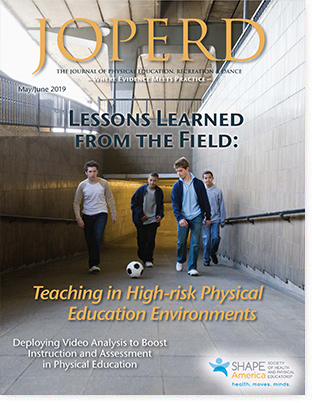 JOPERD Table of Contents
JOPERD Table of Contents
Lessons Learned from the Field: Teaching in High-Risk Physical Education Environments
Zachary Wahl-Alexander, Jennifer M. Jacobs, Timothy Mack

According to the U.S. Department of Education (USDE), a child is considered “at risk” if they receive low academic achievement scores, are at risk of dropping out of school, have little support from parents, or live in a low-socioeconomic neighborhood (USDE, National Center for Education Statistics, 2011). Currently in the United States, somewhere between 10% and 25% of all youth are considered at risk and attend a Title-1 funded public school (USDE, Office of Elementary and Secondary Education, Office of State Support, 2015). Further, at any given time, over 1.5% of youth are incarcerated in youth detention centers nationwide (Sickmund, Sladky, Kang, & Puzzanchera, 2014). While it would be unfair to judge these children based on preconceived qualities that in many cases are out of their control, it is reasonable to suggest that many children in these low-socioeconomic communities and juvenile detention centers are not receiving adequate opportunities to be physically active. This can be attributed to several factors including a lack of funding, space and equipment, or a dearth of quality physical education teachers who have the needed experience and confidence to teach in the most difficult of environments.
Although teachers can face many challenges when teaching in these “at risk” contexts, the purpose of this article is to offer tangible practices that the authors have used in similar environments to deliver high-quality physical education. Given the authors’ expertise and familiarity with models-based instruction, the following strategies were derived from a variety of pedagogical models rooted in positive youth development. Specifically, many of the subsequent strategies were drawn from the teaching personal and social responsibility (TPSR; Hellison, 2011) and sport education models (Siedentop, Hastie, & van der Mars, 2011). The TPSR model is a values-based model originally developed for at-risk youth. The model’s main aims are to impart life values such as leadership, respect and self-control through authentic lessons integrated with physical activity, as well as foster the transfer of these and other life skills to other important life domains (e.g., home, school). Sport education’s primary aims are to create competent, literate and enthusiastic sportspeople by constructing an authentic learning experience. In this model classmates remain on consistent teams and participate in various roles that emphasize and facilitate positive social interactions and forge powerful relationships (Hastie & Wallhead, 2015).
To read the rest of this article, click here to download a pdf.